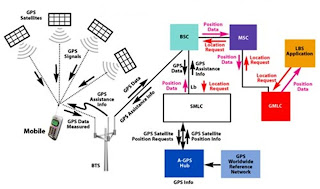The standalone GPS system is susceptible to atmospheric conditions and multipath errors which tend to prolong the time to first fix. This is not appropriate for real time navigation and emergency applications. A-GPS offers a solution to this problem with an architecture that makes use of data connectivity to an Assistance server located at a place with strong signal connectivity with the satellites. There are two possibilities here.
- The assistance server may transmit orbital parameters and atomic time information to the mobile phone via the network. The GPS receiver in the mobile phone correlates this data with the fragmentary data received directly from the satellites thereby increasing its sensitivity and resulting in a quicker time to first fix.
- The mobile phone with limited processing capabilities can delegate the processing function to the more sophisticated assistance server by sending the weak fragmentary data to the processing server that has good satellite signal and receive the position information from the server through the network.
A-GPS is a feasible option to provide navigational services in an urban environment with tall buildings and high radio interference. On the flipside the service provider will charge the subscriber for network data traffic using GPRS/3G.
